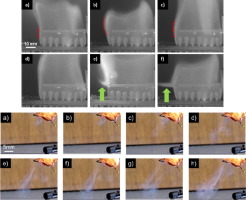当前位置:
X-MOL 学术
›
Exp. Therm. Fluid Sci.
›
论文详情
Our official English website, www.x-mol.net, welcomes your feedback! (Note: you will need to create a separate account there.)
Heat and Mass Transfer Resulting in Eruptive Jetting from Stems and Leaves during Distillation Stage of Forest Fire
Experimental Thermal and Fluid Science ( IF 3.2 ) Pub Date : 2020-08-01 , DOI: 10.1016/j.expthermflusci.2020.110112 W. Zhang , E. Zussman , A.L. Yarin
Experimental Thermal and Fluid Science ( IF 3.2 ) Pub Date : 2020-08-01 , DOI: 10.1016/j.expthermflusci.2020.110112 W. Zhang , E. Zussman , A.L. Yarin

|
Abstract Forest fires are common large-scale environmental disasters with annual death toll and damages on the scale of tens of billions of dollars. They leave scars visible from space. In the context of climate change, forest fire severity is predicted to increase. Not only forest fires release significant amounts of carbon dioxide and ash to the atmosphere, but the diminishing forest area facilitates the greenhouse effect and climate change. However, the internal mechanisms of forest fires are not fully understood, which complicates their prediction, prevention and quenching. We explore a novel mechanism responsible for fuel and water vapor supply into flame in the form of volatiles-water vapor jets erupting from plants engulfed in fire. This mechanism is significantly accelerated in comparison with the ordinary-implied evaporation/sublimation and diffusion characteristic of the diffusion flames. The eruptive jets accelerate fuel supply into the flame zone and plant drying before burning, which facilitates forest fire. They also ballast the flame zone with water vapor, i.e. provide a counter-acting flame-quenching path. Epipremnum aureum stems and oak (Quercus calliprinos) leaves are used in the experiments to study volatiles and water vapor eruption from biomass burning at the distillation stage of forest fire. The eruptive jets are observed in the experiments with horizontal stems and leaves subjected to the engulfing flame, and the results are explained and predicted theoretically. As a model system, a horizontal syringe needle filled with liquids and subjected to the surrounding flame is used as a stem substitute to separate the effect of water vapor from that of combustible volatiles modeled by ethanol. The velocity and temperature of the jets erupting from the horizontal stems or needles subjected to flame are measured and predicted, with the velocity being on the scale of 10 m/s. The theory is in good agreement with the experimental data.
中文翻译:

森林火灾蒸馏阶段茎叶喷发的传热传质
摘要 森林火灾是常见的大规模环境灾害,每年造成的死亡人数和损失达数百亿美元。他们留下从太空可见的疤痕。在气候变化的背景下,森林火灾的严重程度预计会增加。不仅森林火灾会向大气释放大量二氧化碳和灰烬,而且森林面积的减少也促进了温室效应和气候变化。然而,人们对森林火灾的内在机制尚未完全了解,这使得其预测、预防和扑灭变得复杂。我们探索了一种新的机制,负责将燃料和水蒸气以挥发物的形式供应到火焰中,即从被火吞噬的植物中喷出的水蒸气射流。与扩散火焰的普通隐含蒸发/升华和扩散特性相比,这种机制显着加速。喷发的喷气机加速燃料供应进入火焰区和植物在燃烧前干燥,从而促进森林火灾。它们还用水蒸气压载火焰区,即提供反作用的火焰熄灭路径。Epipremnum aureum 茎和橡树 (Quercus calliprinos) 叶用于实验研究森林火灾蒸馏阶段生物质燃烧产生的挥发物和水蒸气喷发。在水平茎叶经受吞没火焰的实验中观察到喷发射流,并对结果进行了理论解释和预测。作为模型系统,水平注射器针头充满液体并受到周围火焰的影响,用作杆替代物,以将水蒸气的影响与乙醇模拟的可燃挥发物的影响分开。测量和预测从受到火焰影响的水平杆或针喷出的射流的速度和温度,速度为 10 m/s。该理论与实验数据吻合良好。
更新日期:2020-08-01
中文翻译:

森林火灾蒸馏阶段茎叶喷发的传热传质
摘要 森林火灾是常见的大规模环境灾害,每年造成的死亡人数和损失达数百亿美元。他们留下从太空可见的疤痕。在气候变化的背景下,森林火灾的严重程度预计会增加。不仅森林火灾会向大气释放大量二氧化碳和灰烬,而且森林面积的减少也促进了温室效应和气候变化。然而,人们对森林火灾的内在机制尚未完全了解,这使得其预测、预防和扑灭变得复杂。我们探索了一种新的机制,负责将燃料和水蒸气以挥发物的形式供应到火焰中,即从被火吞噬的植物中喷出的水蒸气射流。与扩散火焰的普通隐含蒸发/升华和扩散特性相比,这种机制显着加速。喷发的喷气机加速燃料供应进入火焰区和植物在燃烧前干燥,从而促进森林火灾。它们还用水蒸气压载火焰区,即提供反作用的火焰熄灭路径。Epipremnum aureum 茎和橡树 (Quercus calliprinos) 叶用于实验研究森林火灾蒸馏阶段生物质燃烧产生的挥发物和水蒸气喷发。在水平茎叶经受吞没火焰的实验中观察到喷发射流,并对结果进行了理论解释和预测。作为模型系统,水平注射器针头充满液体并受到周围火焰的影响,用作杆替代物,以将水蒸气的影响与乙醇模拟的可燃挥发物的影响分开。测量和预测从受到火焰影响的水平杆或针喷出的射流的速度和温度,速度为 10 m/s。该理论与实验数据吻合良好。


























 京公网安备 11010802027423号
京公网安备 11010802027423号